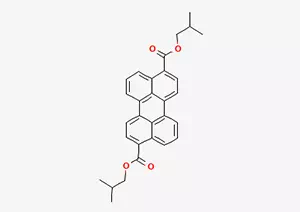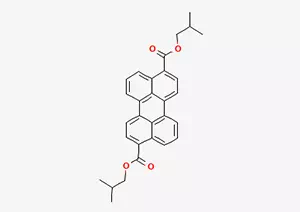All Categories


solvent green 5 CAS 2744-50-5, Solvent Green 5, CAS 2744-50-5
Dark green powder: It presents a rich and bright dark green color, with fine particles and a powder-like form. This powder has a unique color and texture. Under specific lighting conditions, it emits a steady and deep green luster.
CAS : 2744-50-5
Formula : C30H28O4
Mol. wt. : 452.54
EINECS : 220-379-8
Chemical Name | Solvent Green 5 |
Other Name | Diisobutyl Perylenedicarboxylate; Elbaplast Fluorescent Green B |
CAS | 2744-50-5 |
EINECS | 220-379-8 |
Type | Fuel; Organic raw materials |
Molecular Formula | C30H28O4 |
Molecular Weight | 452.54 |
Boiling point | 614.3±28.0 °C(Predicted) |
density | 1.217±0.06 g/cm3(Predicted) |
storage temp. | Sealed in dry,Room Temperature |
solubility | slightly sol. in Toluene |
form | powder to crystal |
color | Light yellow to Yellow to Orange |
Dark green powder: It presents a rich and bright dark green color, with fine particles and a powder-like form. This powder has a unique color and texture. Under specific lighting conditions, it emits a steady and deep green luster.
Insoluble in water: When this powder is placed in water, it does not undergo any dissolution reaction with water and remains in its solid state, quietly settling at the bottom of water and forming a distinct stratification phenomenon with water. The two are immiscible and the boundary is clearly visible.
Good solubility in oily solvents: This powder demonstrates excellent solubility in various oily solvent environments. Whether it is common organic solvents such as toluene and xylene, or some specific oil-based solvents, it can be relatively easily dispersed and dissolved in them, forming a uniform and stable solution system, providing convenient conditions for subsequent applications.
Solvent Green 5 is obtained by the reaction of 3, 9-perylene dicarboxylic acid and isobutanol in the presence of phosphorus trichloride and nitrobenzene as the solvent. In the specific chemical reaction process, all the required raw materials and solvents should be prepared first. 3, 9-perylene dicarboxylic acid and isobutanol were weighed and mixed in a certain proportion, and then the mixture was placed in a reaction system with nitrobenzene as the solvent. Meanwhile, phosphorus trichloride is added to this reaction system as a catalyst for the reaction or a key substance involved in the reaction. Under suitable reaction conditions such as temperature and pressure, a chemical reaction occurs between 3, 9-perylene dicarboxylic acid and isobutanol. After a series of complex chemical change processes, the product of solvent green 5 is finally generated.
Using 3, 9-perylene dicarboxylic acid and isobutanol as raw materials and nitrobenzene as the solvent, the two are condensed in the presence of phosphorus trichloride to obtain the product. Specifically, before the reaction starts, an appropriate amount of 3, 9-perylene dicarboxylic acid and isobutanol are precisely weighed and placed in a specific reaction vessel. Next, pour in nitrobenzene as the solvent to ensure that the raw materials can be fully dissolved and mixed in it. Subsequently, phosphorus trichloride is slowly added to initiate the reaction. During the reaction process, the molecules of 3, 9-perylene dicarboxylic acid and isobutanol gradually approach each other and undergo condensation reactions under the action of phosphorus trichloride. Through the breaking and recombination of chemical bonds between molecules, new chemical structures are formed, and eventually the products we need are obtained.
After post-treatment steps such as solvent recovery and finished product drying: Once the reaction is completed, a series of post-treatment operations need to be carried out on the reaction system next. The first step is solvent recovery. Through specific separation techniques, the solvent nitrobenzene used in the reaction process is separated from the reaction mixture and recovered. This step not only enables the recycling of solvents and reduces production costs, but also meets environmental protection requirements. After the solvent recovery is completed, the remaining products are dried. Adopt appropriate drying methods and equipment to remove residual moisture and other volatile impurities in the product, ensuring its purity and quality.
The product contains a small amount of 3,10 isomers: In the final obtained product, in addition to the main components, there are also a small amount of 3,10 isomers. The existence of this isomer is due to the fact that during the chemical reaction process, the conformation and arrangement of molecules have a certain degree of randomness, resulting in some molecules forming 3,10 isomer structures that are similar in structure to but slightly different from the target product. Although its content is relatively small, to a certain extent, it will also affect some properties and application performance of the product.

In the field of chemical coloring, solvent Green 5 has extremely wide and important applications. Among them, it is mainly used for coloring various types of oils. Whether it is common edible oil or lubricating oil, fuel oil and other oils used in industry, solvent Green 5 can play an excellent coloring role, giving these oils specific color labels and making them better distinguished and identified.
Meanwhile, the solvent Green 5 has also demonstrated excellent performance in coloring plastics, resins and their products. Its existence can be seen in the production process of many plastic products. For example, polyolefin is a widely used plastic material. When manufacturing various daily necessities and industrial components, adding the solvent Green 5 can make it present a uniform, stable and required color, improving the appearance quality and market competitiveness of the products.
For ABS (acrylonitrile-butadiene-styrene copolymer) plastic products, solvent Green 5 is also a rare colorant. It can be well compatible with ABS material. Without affecting the original performance of the material, it can bring bright and lasting colors to the products, making ABS products more attractive in fields such as electronic device shells and automotive parts.
PC (polycarbonate) material is widely used in many fields such as spectacle lenses and electronic display screens due to its excellent mechanical properties and optical characteristics. During the coloring process of PC products, solvent Green 5 can precisely control the depth and uniformity of the color, meeting the strict requirements of different industries for color accuracy and adding a unique visual effect to PC products.
PS (polystyrene), as a common plastic raw material, is widely used in packaging materials, disposable tableware and other aspects. Solvent Green 5 can offer a wide range of color options for PS products, from fresh light green to rich dark green, all of which can be easily achieved, thus meeting the color preference needs of different consumers.
PET (polyethylene terephthalate) products, such as common beverage bottles, after being colored with solvent Green 5, can not only enhance the product's recognition but also improve its protective performance to a certain extent and extend its service life.
Furthermore, for plastic materials with high transparency and good gloss such as acrylic acid, solvent Green 5 can also be perfectly matched with them. When coloring acrylic products, it can not only maintain their original transparency and luster, but also endow them with a fresh and natural green tone, enabling them to play a greater value in decoration, display and other fields.
In addition to the common plastic products mentioned above, solvent Green 5 can also be used for coloring polyester fiber pulp. During the production and processing of polyester fiber pulp, adding an appropriate amount of solvent green 5 can make the pulp present a uniform color, giving the subsequent paper or paperboard products unique appearance features and meeting the color requirements for different uses.
* Prompt reply and 24 hours online, professional team to provide best price and high quality product.
* Sample testing support.
* Every batch of products will be tested to ensureits quality.
*The packing also can be according the customers` requirment.
*Any inquiries will be replied within 24 hours.
*we provide Commerical Invoice, Packing List, Bill of loading, COA , Health certificate and Origin certificate. If your markets have any special requirements, let us know.